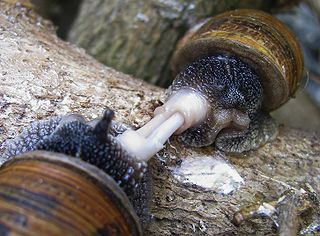
The cell is the basic structural, functional, and biological unit of all known organisms. A cell is the smallest unit of life. Cells are often called the "building blocks of life". The study of cells is called cell biology, cellular biology, or cytology.

The immune system is a host defense system comprising many biological structures and processes within an organism that protects against disease. To function properly, an immune system must detect a wide variety of agents, known as pathogens, from viruses to parasitic worms, and distinguish them from the organism's own healthy tissue. In many species, there are two major subsystems of the immune system: the innate immune system and the adaptive immune system. Both subsystems use humoral immunity and cell-mediated immunity to perform their functions. In humans, the blood–brain barrier, blood–cerebrospinal fluid barrier, and similar fluid–brain barriers separate the peripheral immune system from the neuroimmune system, which protects the brain.
Heterogamy is a term applied to a variety of distinct phenomena in different scientific domains. Usually having to do with some kind of difference, "hetero", in reproduction, "gamy". See below for more specific senses.

Self-organization, also called spontaneous order, is a process where some form of overall order arises from local interactions between parts of an initially disordered system. The process can be spontaneous when sufficient energy is available, not needing control by any external agent. It is often triggered by seemingly random fluctuations, amplified by positive feedback. The resulting organization is wholly decentralized, distributed over all the components of the system. As such, the organization is typically robust and able to survive or self-repair substantial perturbation. Chaos theory discusses self-organization in terms of islands of predictability in a sea of chaotic unpredictability.
Endogamy is the practice of marrying within a specific social group, caste, or ethnic group, rejecting those from others as unsuitable for marriage or other close personal relationships.

Storge or familial love refers to natural or instinctual affection, such as the love of a parent towards offspring and vice versa.
Homophily from Ancient Greek ὁμοῦ and Greek φιλία is the tendency of individuals to associate and bond with similar others, as in the proverb "birds of a feather flock together". The presence of homophily has been discovered in a vast array of network studies. More than 100 studies have observed homophily in some form or another and they establish that similarity breeds connection. These include age, gender, class, and organizational role.

Marek Jerzy Minakowski is a Polish philosopher, historian, genealogist, doctor of humanities, publisher, blogger, and YouTuber. He founded the Wielka Genealogia Minakowskiego ; and cofounded and is first marszałek (chairman) of Stowarzyszenie Potomków Sejmu Wielkiego.

Biological or process structuralism, also known as formalism, is a school of biological thought that objects to an exclusively Darwinian or adaptationist explanation of natural selection such as is described in the 20th century's modern synthesis. It proposes instead that evolution is guided differently, basically by more or less physical forces which shape the development of an animal's body, and sometimes implies that these forces supersede selection altogether.

Biological organization is the hierarchy of complex biological structures and systems that define life using a reductionistic approach. The traditional hierarchy, as detailed below, extends from atoms to biospheres. The higher levels of this scheme are often referred to as an ecological organization concept, or as the field, hierarchical ecology.

Humberto Maturana is a Chilean biologist turned philosopher. Many consider him a member of a group of second-order cybernetics theoreticians such as Heinz von Foerster, Gordon Pask, Herbert Brün and Ernst von Glasersfeld.

In biology, a hermaphrodite is an organism that has complete or partial reproductive organs and produces gametes normally associated with both male and female sexes. Many taxonomic groups of animals do not have separate sexes. In these groups, hermaphroditism is a normal condition, enabling a form of sexual reproduction in which either partner can act as the "female" or "male". For example, the great majority of tunicates, pulmonate snails, opisthobranch snails, earthworms, and slugs are hermaphrodites. Hermaphroditism is also found in some fish species and to a lesser degree in other vertebrates. Most plants are also hermaphrodites.
Age disparity in sexual relationships is the difference in ages of individuals in sexual relationships. Concepts of these relationships, including what defines an age disparity, have developed over time and vary among societies. Differences in age preferences for mates can stem from evolutionary mating strategies and age preferences in sexual partners may vary cross-culturally. There are also social theories for age differences in relationships as well as suggested reasons for 'alternative' age-hypogamous relationships. Age-disparity relationships have been documented for most of recorded history and have been regarded with a wide range of attitudes dependent on sociocultural norms and legal systems.
Heterophily, or love of the different, is the tendency of individuals to collect in diverse groups; it is the opposite of homophily. This phenomenon can be seen in relationships between individuals. As a result, it can be analyzed in the workplace to create a more efficient and innovative workplace. It has also become an area of social network analysis.
An individual is that which exists as a distinct entity. Individuality is the state or quality of being an individual; particularly of being a person separate from other people and possessing their own needs or goals, rights and responsibilities. The exact definition of an individual is important in the fields of biology, law, and philosophy.
Filter theory is a sociological theory concerning dating and mate selection. It proposes that social structure limits the number of eligible candidates for a mate. Most often, this takes place due to homogamy, as people seek to date and marry only those similar to them. Homogamy is the idea of marriage between spouses who share similar characteristics, where heterogamy denotes marriage between spouses of different characteristics. The idea of "opposites attract: is heterogamous as well as the idea that one spouse has complementing, not similar characteristics to the other.
Tim B. Heaton is an American educator and sociologist. He has been called the leadering expert on the demographics of Mormons.
Homogamy is marriage between individuals who are, in some culturally-important way, similar to each other. It is a form of assortative mating. The union may be based on socioeconomic status, class, gender, ethnicity, or religion, or age in the case of the so-called age homogamy.

Homogamy is used in biology in four separate senses:
Radhika Nagpal is an American computer scientist and researcher in the fields of self-organising computer systems, biologically-inspired robotics, and biological multi-agent systems. She is the Fred Kavli Professor of Computer Science at Harvard University and the Harvard School of Engineering and Applied Sciences. She is also a Core Faculty Member of the Harvard Wyss Institute for Biologically Inspired Engineering. In 2017, Nagpal co-founded a robotics company under the name of Root Robotics. This educational company works to create many different opportunities for those unable to code to learn how.









